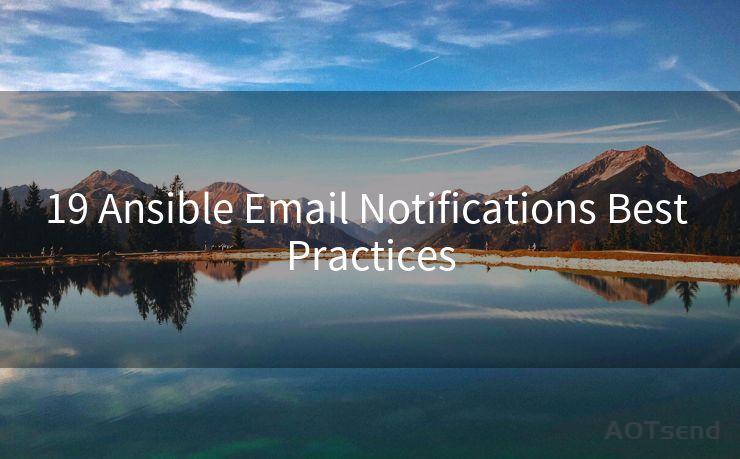19 Ansible Email Notifications Best Practices




1. Introduction
Ansible is a powerful automation tool that simplifies IT tasks, including configuration management, application deployment, and more. One of the key features of Ansible is its ability to send email notifications, keeping teams informed about the status of their automation tasks. In this blog post, we'll explore 19 best practices for setting up and using Ansible email notifications effectively.
2. Configure SMTP Settings Correctly
Before you can send email notifications from Ansible, you need to ensure your SMTP (Simple Mail Transfer Protocol) settings are correctly configured. This involves specifying the SMTP server, port, username, password, and other relevant details in your Ansible configuration.
3. Use SSL/TLS for Secure Communication
When sending emails, it's crucial to ensure that the communication between Ansible and the SMTP server is secure. Enable SSL/TLS encryption to prevent unauthorized access to sensitive information.
4. Customize Email Templates
Ansible allows you to customize email templates, which means you can control the look and feel of your notifications. Take advantage of this feature to create professional and informative emails that suit your organization's branding.
5. Include Relevant Information
When crafting your email notifications, make sure to include all the relevant information that recipients need to understand the context and take appropriate action. This may include task details, execution results, and links to additional resources.
6. Send Notifications to Multiple Recipients
Ansible supports sending notifications to multiple email addresses. Utilize this functionality to keep all stakeholders informed, from IT teams to management.
7. Use Conditional Logic for Targeted Notifications
You don't always need to notify everyone about every task. Use Ansible's conditional logic to send notifications only when certain conditions are met, such as task failures or successful completions.
8. Leverage Jinja2 Templates for Dynamic Content
Ansible supports Jinja2 templating, which allows you to insert dynamic content into your email notifications. Use this feature to include variables, loops, and conditional statements in your emails.
9. Test Email Notifications Before Deployment
Before deploying your Ansible playbook, test your email notifications to ensure they work as expected. This helps avoid any surprises or issues when the playbook is executed in a production environment.
10. Monitor and Troubleshoot Email Delivery
Regularly monitor your email notifications to ensure they are being delivered successfully. If you encounter any issues, troubleshoot promptly to maintain the effectiveness of your notification system.
11. Optimize Email Frequency and Content
Strike a balance between keeping stakeholders informed and avoiding email overload. Optimize the frequency and content of your notifications to ensure they are relevant and actionable.
12. Utilize Email Threading
By threading emails, you can group related notifications together, making it easier for recipients to track and manage their inbox. Configure your email client to support threading for a better user experience.
🔔🔔🔔
【AOTsend Email API】:AOTsend is a Managed Email Service for sending transactional emails. Support Email Types: reminders, authentication, confirmations, notifications, verification codes, invoices, password resets, account activations, billing statements, two-factor authentication (2FA), and one-time passwords (OTP) emails, etc. $0.28 per 1000 Emails. 99% Delivery, 98% Inbox Rate.
You might be interested in:
Why did we start the AOTsend project, Brand Story?
What is a Managed Email API, How it Works?
Best 25+ Email Marketing Platforms (Authority,Keywords&Traffic Comparison)
Best 24+ Email Marketing Service (Price, Pros&Cons Comparison)
Email APIs vs SMTP: How they Works, Any Difference?
13. Archive Important Notifications
For critical tasks or incidents, consider archiving important email notifications. This ensures that vital information is preserved for future reference or auditing purposes.
14. Integrate with External Systems
Integrate Ansible's email notifications with external systems like ticketing platforms or monitoring tools. This allows for a more comprehensive IT management workflow.

15. Follow Email Best Practices
Adhere to general email best practices, such as using clear and concise subject lines, avoiding spam triggers, and optimizing for mobile devices.
16. Update Notification Settings Regularly
As your organization's needs change, regularly review and update your Ansible email notification settings to ensure they remain relevant and effective.
17. Provide Feedback Mechanisms
Include a feedback mechanism in your email notifications, allowing recipients to provide input on the usefulness and relevance of the information they receive.
18. Document Your Notification Process
Document your Ansible email notification process, including triggers, templates, and recipient lists. This ensures continuity and ease of troubleshooting in the future.
19. Stay Up to Date with Ansible Updates
Keep up to date with Ansible updates and enhancements, as they may include improvements to the email notification functionality.
By following these best practices, you can effectively utilize Ansible's email notification capabilities to keep your team informed and enhance your organization's IT automation efforts.




Scan the QR code to access on your mobile device.
Copyright notice: This article is published by AotSend. Reproduction requires attribution.
Article Link:https://www.mailwot.com/p6255.html



